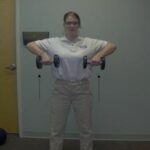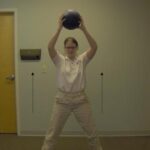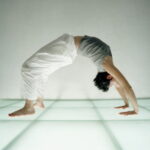The indications and contraindications for PNF (Proprioceptive Neuromuscular Facilitation) stretching are similar to those of any type of stretching. Indications include a loss of ROM, acute pain, chronic pain, muscle tightness, muscle cramps, and a lack of flexibility in the involved area.
Contraindications for PNF stretching include recent post-op athletes, instability of joint or area, athletes under the age of 18, untrained or uninstructed athletes, and already stretched muscles using the PNF technique. Post-op athletes should not perform this type of stretching because the repairs that were made during surgery may be counteracted (muscles or tendons pulling away from reattachment) due to the tension stretching implements. Tissue healing must be determined before intense stretching can be performed.
If an athlete has an unstable joint in the area that the stretching is being applied, they may not be able to control the movement of the stretch and hypermobility may cause injury. PNF stretching is not recommended for anyone under the age of 18 because intense stretching, such that PNF causes, may disrupt the growth plates and cause injuries such as Osgood- Schlatter’s disease. Last, it is not good to perform PNF stretching more than once a day due to the amount of stress it places on the muscle and tendons.
There are many variations and names for the different PNF stretching techniques. The following is a list of techniques and names commonly used: contract-relax, hold-relax, slow-reversal-hold-relax, agonist contraction, contract-relax-agonist-contract, and hold-relax-agonist-contract. Most of the confusions over the proper name of each technique comes because of PNF stretching’s original description. They were originally specified diagonal patterns, whereas today most clinicians recommend moving in straight planes.
The three most common patterns will be discussed in the following section of proper instruction in order to avoid confusion. These patters are contract-relax, hold-relax, and slow-reversal-hold-relax. In order for PNF stretches to be most beneficial, two people should perform the technique together. It is essential that one be trained in PNF patterns. Some PNF patterns can be performed alone with the use of a wall or theraband, but partner stretching is mainly used.
For the following, the person being stretched will be known as the athlete and the assisting stretcher will be known as the athletic trainer. Most of these patterns are used on the lower leg to stretch the hamstrings. For this reason, an example of the stretch will be used at the end of each section using the hamstrings for the muscle being stretched.
Contract-relax
The athlete should lay supine on a table or on the ground. The athletic trainer passively moves the athlete’s limb to the endpoint of the ROM. At this point, the athlete is instructed to concentrically contract the opposite muscle (agonist) to the muscle being stretched. This will slightly cause more of a stretch. The athletic trainer should not push the limb into any more of a stretch at this time, this is simply an active concentric contraction causing more of a stretch.
The athletic trainer should now keep the limb in the new stretched position and instruct the athlete to relax. This stretch should be held for 10 to 15 seconds. This pattern of contracting and relaxing should be repeated 3 to 5 times without lowering the limb. Once the last sequence has been finished, the limb should be lowed slowly.
To stretch the hamstring with this technique, the athletic trainer flexes the hip to the full ROM. The athlete should then contract the quad in order to gain a greater stretch. The athletic trainer should tell the athlete to relax at this point and should hold the new position for 10 to 15 seconds. This should be repeated 3 to 5 times without lowering the leg. Once the last stretch is completed, the athletic trainer should slowly lower the leg back to the table or the ground.
Hold-relax
The athlete should lay supine on a table or on the ground. The athletic trainer should passively move the limb to the endpoint of the ROM. At this point, the athlete should push the limb against the athletic trainer’s force while the athletic trainer keeps the same position. This is an isometric contraction of the antagonist muscle (muscle being stretched). This contraction should be held of 10 seconds. At the end of the 10 seconds, the athlete is told to relax and the athletic trainer should immediately passively move the limb into a further stretch than the original position. This new position is held for 10 to 15 seconds. This sequence of isometric contraction and passive stretching should be done 3 to 5 times without lowering the limb. At the end of the sequence, the limb should be lowered slowly.
To stretch the hamstring using this technique, the athletic trainer should flex the hip to the end ROM. At this point, the athlete should isometrically contract the hamstrings for 10 seconds. The athlete then relaxes and the athletic trainer passively moves the leg into a further stretch. This new position should be held for 10 to 15 seconds. This should be repeated 3 to 5 times without lowering the leg. Once the last stretch has been completed, the athletic trainer should lower the leg slowly back onto the table or the ground.
Slow-reversal-hold-relax
The athlete should lay supine on a table or on the ground. The athletic trainer should passively move the limb to the endpoint of the ROM. At this point, the athlete should apply an isometric contraction against the athletic trainer using the antagonist muscle (muscle being stretched). This contraction should be held for 10 seconds. At the end of the 10 seconds, the athlete should be told to concentrically contract the opposite muscle from the muscle being stretched (agonist muscle). This will cause the limb to move into more of a stretch past the original position. The athletic trainer should not push the limb into a further stretch, only the action of the athlete should pull the limb to the new position. At this point, the athlete is told to relax and the athletic trainer should hold the limb in the new position of 10 to 15 seconds. This sequence of isometric contraction and concentric contraction should be done 3 to 5 times without lowering the limb. Once the final stretch has been completed, the limb should be lowered slowly.
For the hamstrings to be stretched using this technique, the athletic trainer should flex the hip to the end ROM. The athlete should then isometrically contract for 10 seconds using the hamstrings. After the 10 seconds, the athlete should then concentrically contract the quad to pull the leg into a further stretch. The athletic trainer should hold this new position for 10 to 15 seconds while the athlete relaxes. This sequence should be done 3 to 5 times without lowering the leg. When the last stretch has been done, the athletic trainer should lower the leg back to the table or the ground.
The groin is complex enough to stretch that it has it’s own special method. The athlete should lay supine on a table or the ground and place their heals together while letting their knees fall to the outside. The athlete then brings their heals as close to the groin area as possible. The athletic trainer should then push their heals closer to the groin until the athlete feels slight resistance. The athletic trainer should then place their knees around the athlete’s feet so they are immobile.
The athletic trainer should place their hands on the athlete’s knees. The athlete then isometrically contracts against the athletic trainer’s resistance for 5 seconds. The athlete is then told to relax and the athletic trainer pushes the athlete’s knees down towards the table or ground until the athlete feels some resistance. The athletic trainer should hold this new position for 10 to 15 seconds. This sequence should be done 3 to 5 times.







